Northern Vietnam, a land of outstanding people and natural beauty, is not only famous for its majestic landscapes but also the cradle of wet rice civilization, preserving the national identity through hundreds, even thousands of years of history. Amidst the bustling pace of urbanization, peaceful ancient villages still exist like precious gems, quietly telling stories of an old, tranquil, and culturally rich Vietnam. If you seek tranquility, escaping the noisy city, join “Du lịch khắp thế gian” to explore the most beautiful ancient villages in Northern Vietnam, where time seems to stand still, allowing you to fully experience the beauty of Vietnamese tradition and culture.
Cuu Village – An Ancient French Village in the Heart of Hanoi
Hidden in bustling Hanoi, Cuu Village in Phu Xuyen district resembles a unique architectural oasis, where the ancient beauty of Vietnam and the romantic French style intersect. With over 500 years of history, Cuu Village amazes every visitor with its unique architecture. Ancient villas bearing French colonial imprints, interspersed with traditional Northern Vietnamese houses, create a rural painting that is both strange and familiar.
Walking along the winding alleys, visitors will feel a peaceful, quiet space, completely different from the hustle and bustle of the capital. Mossy walls, bright red tile roofs, and solemn wooden gates all blend together, creating an atmosphere imbued with nostalgia. Cuu Village attracts not only by its unique architecture but also by its fresh air and friendly, rustic people, offering visitors a feeling of relaxation and tranquility.
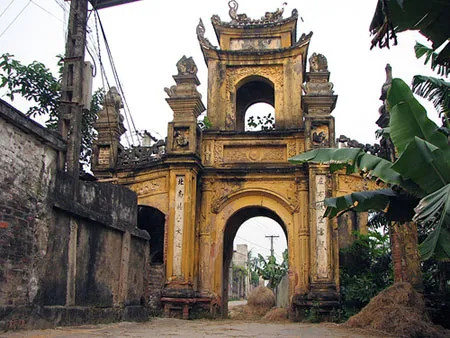
Exploring Cuu Village:
- Unique Architecture: The highlight of Cuu Village is its ancient houses with French architectural style, built in the early 20th century. Villas with red tile roofs, yellow walls, blue windows, and winding iron balconies create a luxurious, classic beauty. Besides, the village still retains traditional Vietnamese wooden houses with curved tile roofs, lotus ponds, and wells, bearing the traditional Vietnamese architectural style.
- Historical Relics: Cuu Village also has many historical and cultural relics such as communal houses, ancient pagodas, and temples, which are places of spiritual activities and preserve the cultural values of the village.
- Peaceful Space: Coming to Cuu Village, visitors will immerse themselves in the peaceful countryside space, away from the noise of the city. Strolling along the village roads, breathing in the fresh air, and admiring the ancient houses will be a memorable experience.
Travel Tips for Cuu Village:
- Time to Visit: You should visit Cuu Village in autumn or spring when the weather is cool and pleasant.
- Transportation: Cuu Village is about 40km from the center of Hanoi; you can travel by motorbike, car, or bus.
- Dining: You can enjoy Phu Xuyen countryside specialties such as Mia chicken, black carp, and Sau sang vegetables at eateries in the village or roadside restaurants.
Duong Lam Ancient Village – A Living Museum of Northern Architecture
Dubbed a “living museum” of Northern architecture and culture, Duong Lam ancient village in Son Tay town, Hanoi, is one of the most ancient villages in Vietnam. With a history of over 1000 years, Duong Lam still preserves the typical features of a traditional ancient Vietnamese village with a village gate, banyan tree, well, communal house yard, and mossy tiled roofs.
Duong Lam is not only a village but also a priceless cultural heritage, preserving the unique historical, cultural, architectural, and artistic values of the nation. Every house, every road, every brick in Duong Lam carries the mark of time, telling stories of the glorious past of this land. Coming to Duong Lam, visitors will not only admire the ancient architectural beauty but also immerse themselves in the traditional cultural space, learning about the history and customs of the local people.
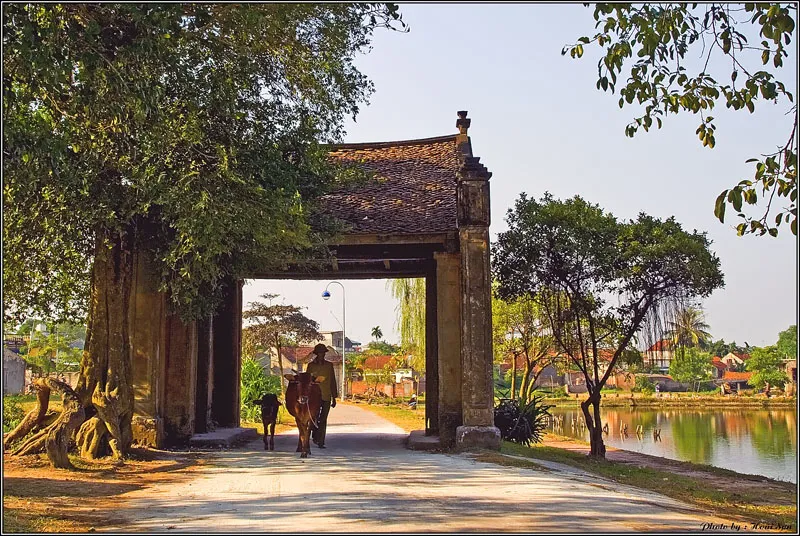
Exploring Duong Lam Ancient Village:
- Ancient House Architecture: Duong Lam is famous for its ancient houses built of brick, laterite, and wood, dating back hundreds of years. The house architecture in Duong Lam bears the traditional Northern style with bright red tiled roofs, golden laterite brick walls, and spacious, airy gardens.
- Spiritual Structures: Mong Phu Communal House, Mia Pagoda, Tham Hoa Giang Van Minh Temple are famous spiritual architectural works in Duong Lam, bearing significant cultural and historical values.
- Local Products: Duong Lam is also famous for many local products such as Duong Lam soy sauce, Mia chicken, and Che kho (sweetened green bean flakes). Visitors can buy them as gifts or enjoy them at eateries in the village.
Travel Tips for Duong Lam Ancient Village:
- Time to Visit: The best time to visit Duong Lam is in autumn or spring.
- Transportation: Duong Lam is about 44km from the center of Hanoi; you can travel by motorbike, car, or bus.
- Accommodation: You can choose to stay at homestays in the village to experience rural life or hotels in Son Tay town.
- Combine Sightseeing: You can combine visiting Duong Lam ancient village with other tourist attractions in Son Tay such as Son Tay Ancient Citadel, Va Temple, and Mang Son Temple.
Bat Trang Pottery Village – Where the Soul of Clay Ascends
Located on the left bank of the Red River, Bat Trang pottery village in Gia Lam district, Hanoi, is one of the most famous traditional craft villages in Vietnam. With a history of over 700 years, Bat Trang has become a symbol of Vietnamese ceramics, famous for its exquisite, unique products imbued with national cultural identity.
Coming to Bat Trang, visitors will not only admire the beautiful ceramic products but also discover the traditional pottery production process, try their hand at making pottery, and learn about the history and culture of the craft village. Bat Trang is an attractive destination for those who love ceramics, want to learn about Vietnamese culture, and experience the traditional craft village space.
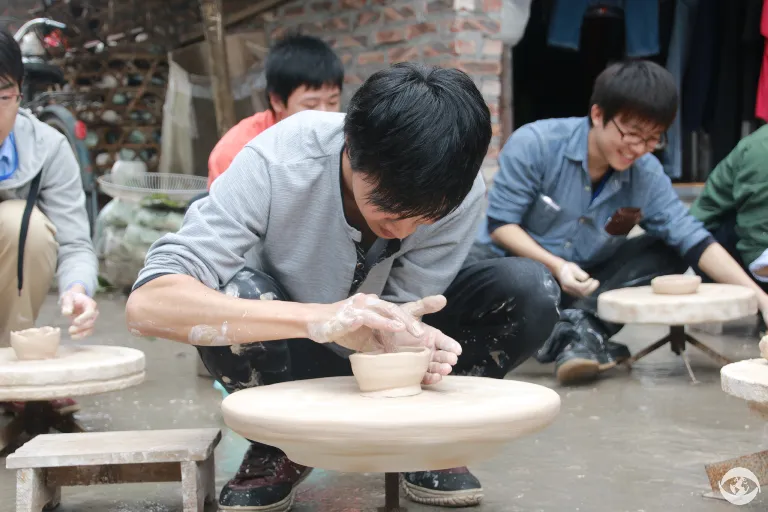
Exploring Bat Trang Pottery Village:
- Pottery Workshops: Visit pottery workshops in the village to witness firsthand the traditional pottery production process from soil selection, shaping, glazing to firing.
- Bat Trang Pottery Market: Bat Trang Pottery Market is a place to display and sell a variety of ceramic products with many designs, styles, and prices. Visitors can freely shop for souvenirs or household items.
- Pottery Making Experience: Participate in pottery making classes to create your own unique ceramic products. This is an interesting and meaningful experience when coming to Bat Trang.
- Culinary Culture: Enjoy Bat Trang specialties such as Banh te (pyramidal rice dumpling), Banh san (cassava cake), and Dong Du guava.
Travel Tips for Bat Trang Pottery Village:
- Time to Visit: Bat Trang is open to visitors all year round; you can come at any time.
- Transportation: Bat Trang is about 15km from the center of Hanoi; you can travel by motorbike, car, bus, or boat on the Red River.
- Shopping: When buying ceramics in Bat Trang, you should bargain to get the best price.
- Attire: You should wear comfortable, easy-to-move clothing when visiting and experiencing pottery making.
Uoc Le Village – Beautiful Customs Bestowed
Uoc Le village in Thanh Oai district, Hanoi, is not only famous for its renowned Gio cha (Vietnamese sausage) but also known as an ancient village with unique architecture and long-standing customs. Right from the village gate, Uoc Le impresses visitors with its ancient, majestic beauty imbued with Vietnamese cultural identity.
The gate of Uoc Le village is built in the traditional arch style, with sturdy red bricks and curved tile roofs like sword blades. On the village gate tower hangs the large inscription “My tuc kha phong” (Beautiful customs bestowed), a noble title bestowed by King Tu Duc to Uoc Le village to recognize the good customs of the local people. Uoc Le village is not noisy or bustling like many other craft villages; it still retains its peaceful, tranquil, and deeply rural atmosphere.
Exploring Uoc Le Village:
- Uoc Le Village Gate: The ancient village gate is a symbol of Uoc Le village, bearing significant cultural and historical values.
- Ancient Architecture: Uoc Le village still retains many ancient houses, markets, and architectural works imbued with the mark of time.
- Uoc Le Gio cha: Enjoy the famous Uoc Le Gio cha, a specialty not to be missed when visiting the village.
- Uoc Le Market: Visit Uoc Le market to learn about the daily life of local people and shop for local specialties.
Travel Tips for Uoc Le Village:
- Time to Visit: You should visit Uoc Le village during village festivals or weekends to experience the vibrant atmosphere and enjoy traditional cultural activities.
- Transportation: Uoc Le village is about 30km from the center of Hanoi; you can travel by motorbike, car, or bus.
- Dining: In addition to Gio cha, you can enjoy other rustic dishes at eateries in the village.
- Respect Culture: When visiting Uoc Le village, you should respect local customs and culture.
Tho Ha Village – Renowned for Ancient Pottery, Famous for Banh Da
Tho Ha village, located in Viet Yen district, Bac Giang province, is about 50km north of Hanoi. Situated by the gentle Cau River, Tho Ha is one of the rare ancient villages that still preserves the unique traditional culture of the Kinh Bac region. From lifestyle, architecture, spirituality to production, Tho Ha bears the imprint of an ancient Vietnamese village.
Tho Ha was once famous for pottery making from the 14th century; Tho Ha pottery was known for its good quality, beautiful designs, and unique characteristics. However, from the 1990s, the pottery craft in Tho Ha gradually declined, and people switched to making Banh da nem (rice paper) and rice vermicelli. Nevertheless, Tho Ha still retains its traditional cultural values, especially its ancient architecture and peaceful village space.
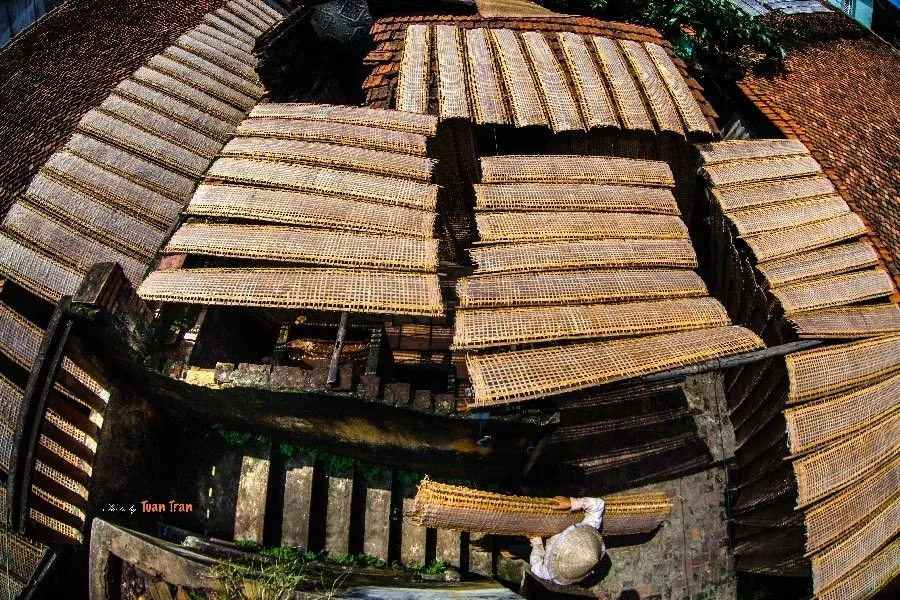
Exploring Tho Ha Village:
- Unique Architecture: Tho Ha is famous for its unique architecture, from houses and village gates to ancient wells, all made of baked bricks and terracotta reliefs without glaze.
- Tho Ha Communal House and Tho Ha Pagoda: These are ancient architectural works, typical of traditional Vietnamese architecture, and must-visit destinations when coming to Tho Ha.
- Banh Da Nem and Rice Vermicelli Craft: Learn about the traditional Banh da nem and rice vermicelli making craft of the village, enjoy, and buy them as gifts.
- Village Space: Stroll through the small alleys, admire the ancient houses, and feel the peaceful space and fresh air of the Northern Vietnamese countryside.
Travel Tips for Tho Ha Village:
- Time to Visit: The best time to visit Tho Ha is in autumn or spring.
- Transportation: Tho Ha is about 50km from the center of Hanoi; you can travel by motorbike, car, or bus.
- Dining: Enjoy Tho Ha Banh da nem, rice vermicelli, and other Bac Giang specialties.
- Festivals: If you have the opportunity to visit Tho Ha during the village festival (in January of the lunar calendar), you will immerse yourself in the vibrant festival atmosphere and learn about traditional rituals.
Nom Village – The Soul of Pho Hien
Nom village, located in Hung Yen province, about 60km from Hanoi, is one of the rare ancient villages that still preserves almost intact the traditional beauty of the Northern Delta region. With over 200 years of history, Nom village carries a majestic, ancient beauty and a peaceful, tranquil space. This is the only ancient village of Pho Hien that still exists today, an attractive destination for those who want to learn about the culture and history of this land.
The special feature of Nom village is its unique architectural layout with a large lake in the center of the village, surrounded by ancient houses and ancestral temples of large families. Opposite the village gate, across the lake, is a beautiful architectural complex including the communal house, ancient well, and ancient banyan tree, creating a harmonious, balanced space imbued with Vietnamese village culture.
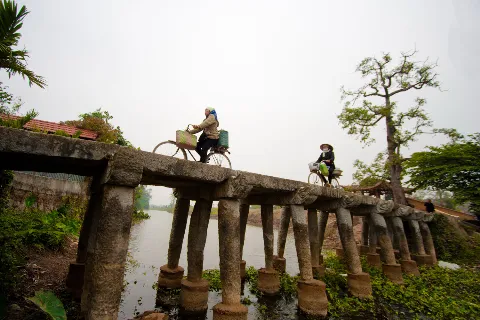
Exploring Nom Village:
- Nom Village Gate: The ancient village gate with unique architecture is the first highlight when coming to Nom village.
- Central Lake: The large lake in the center of the village creates a spacious, peaceful space and is a place for community activities of the people.
- Nom Communal House: Nom Communal House is an ancient architectural work, bearing significant cultural and historical values, a place to worship the village tutelary god and organize traditional festival activities.
- Nom Pagoda: Nom Pagoda (Linh Thong Ancient Pagoda) is a famous ancient pagoda with unique architecture and many precious ancient statues.
- Nom Stone Bridge: The 9-span stone bridge across the Nguyet Duc River is a unique stone architectural work, dating back hundreds of years, and is a symbol of Nom village.
Travel Tips for Nom Village:
- Time to Visit: The ideal time to visit Nom village is in autumn or spring.
- Transportation: Nom village is about 60km from the center of Hanoi; you can travel by motorbike, car, or bus.
- Festivals: Nom village festival is held in January of the lunar calendar every year, an opportunity for visitors to learn about the culture and customs of the village.
- Combine Sightseeing: You can combine visiting Nom village with other tourist attractions in Hung Yen such as Pho Hien, Chuong Pagoda, and Xich Dang Temple of Literature.
The ancient villages of Northern Vietnam are not only attractive tourist destinations but also places that preserve the unique cultural, historical, and architectural values of the nation. Take time to explore and feel the simple, peaceful, and culturally rich beauty of these villages to better understand the soul of the Vietnamese countryside.